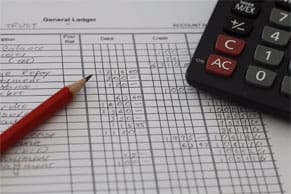Getting paid in full and on time is crucial for any business's cash flow, so late payments and bad debts are a constant threat. Accounts receivable reports are the key tools that enable businesses to manage their accounts receivable (AR) balances, maintain good customer relationships and forecast cash inflows. By alerting businesses to overdue payments, AR reports help companies avoid bad debts.
In recent years, the nature of AR reports has been evolving in many small and midsized businesses as the pace at which those organizations operate accelerates. Instead of the periodically printed documents called to mind by the term “reports,” AR reports are morphing into real-time queries of accounts receivable data, the results of which give business managers up-to-the-minute data, so that their payments and collections interactions with customers are fueled by the most accurate information possible.
Key Takeaways
- Accounts receivable is the money owed to the business by its customers from purchases they don't pay for upfront — i.e., credit sales.
- Paying close attention to accounts receivable helps businesses manage cash flow efficiently and minimize bad debts.
- There are three primary categories of accounts receivable reports: receivables by customer, aging reports and payments history.
- Receivables by customer reports help businesses manage customer relationships and focus attention on critical segments, such as the largest, riskiest or newest customers.
- Aging reports are important for determining the right collections efforts to pursue with a given customer and are helpful in cash flow management.
- Customer payment history reports are important for credit control and cash reconciliations.
What Kind of Reports Are Important for Accounts Receivable (AR)?
“Accounts receivable” is the money owed to your business by its customers from credit sales, and AR is recorded under “current assets” on a company's balance sheet because it's typically due for payment within a year. Managing AR is part of the business's accounting processes, and if sales are strong, the accounts receivable asset on the balance sheet can grow. But a large accounts receivable asset coupled with a low cash balance can be a warning sign that the business is not managing its invoicing and collection efforts efficiently. So, it's important to have reports that dig down below the surface of that accounts receivable asset to inform AR managers, who can then take appropriate action. There are three principal kinds: customer receivable reports, aging reports and payment history reports.
-
Customer receivables reports.
Break down the accounts receivable balance by customer. When customer receivables reports take the form of a real-time display rather than printed paper, businesses can see how receivables change as customer payments arrive and are matched against invoices. Customer receivables reports include open receivables awaiting payment, closed receivables that have been paid and other reports, such as items that have not yet been invoiced (unbilled orders).
-
Aging reports.
Break down unpaid invoices by time — i.e., if, and for how long, they are overdue. They show the extent and length of overdue payments, which businesses can use to take appropriate collection action as well as estimate bad debt. When a business issues an invoice, it typically states the payment terms. Thirty days is the traditional standard, but shorter and longer time periods are also common. A summary aging report categorizes unpaid invoices into intervals based on the payment status. Typical intervals are current (that is, it's not overdue), 1-30 days overdue, 31-60 days, 61-90 days and over 90 days. Summary aging reports typically convey the total invoiced amount outstanding in each time period, while detailed aging reports list the actual invoices outstanding in each period. Aging reports can also be organized by other variables besides the customer account, such as salesperson, region, invoice number and collections agent.
-
Payment history reports.
Show individual customers' payment history. This is important for managing regular customers, especially if they have credit lines. Payment history reports come in two forms: payment history by payment made and payment history by invoice.
How Are Accounts Receivable Reports Used?
AR reports provide visibility into the status of customer payments against current invoices. They’re used for managing customer relationships and cash flow, as well as evaluating the efficiency of a business’s invoicing and credit control processes.
When it comes to customer relationships, business managers need to know how much each customer owes and when monies fall due. It's useful for online or digital customer receivables reports to include alerts for payments that become overdue, so that AR managers can follow up with the customers quickly. Customer receivables reports also show which customers owe the most. This can help business managers improve cash flow by focusing on obtaining faster payment from larger debtors. Customer receivable reports are often analyzed based on some filter, such as region, salesperson or amount of revenue.
Aging reports can be useful for forecasting cash flow. They support business managers in directing collections efforts to minimize bad debts, and help in estimating future cash inflows. In addition to traditional paper reports, digital displays of real-time information can keep business managers fully informed on expected incoming cash. Business managers can also use aging reports to identify customers that are taking a long time to pay and to take timely action to prevent overdue amounts from becoming unrecoverable debts. Different tactics may be used based on the extent of delinquency. A large number of overdue amounts may also signal that the business needs to tighten credit policies for new and existing customers.
Payment history reports help business managers understand the quality of their customer relationships and the effectiveness of their invoicing and credit controls. Payment reports track partial payments as well as full payments and highlight credits and adjustments. Payment activity helps a business evaluate the value of its customer relationships. While every business likes to have regular customers, those that are persistently late with payments or have a history of bad debts can be more trouble than they're worth. Payment reports also give insight into invoicing problems, such as errors and rework. In addition, high levels of invoice adjustments may point toward problems in the company's invoicing processes, product fulfillment or misaligned sales promises. And if too many customers are taking a long time to pay, that's bad for the business's cash flow.
When the data that goes into such AR reports is available via accounting software in real time, it can help a business more efficiently manage credit and collections operations. For example, a business manager might query the software to provide a list of all customer invoices that are 30 days or more past due and/or sort the list from most to least amount owed. The resulting information can help direct collections efforts where they're most productive.
Move beyond traditional reporting.

6 Crucial Accounts Receivable (AR) Reports
Any individual business may have many different ways of analyzing its accounts receivables operations — and as many different AR reports to support them. But the following six types of AR reports are the most commonly used by small and midsized businesses.
-
Accounts Receivable Register:
The AR register report is a list of all the billing activity for a period. Most importantly, the entries in the report represent amounts owed by customers for the purchase of inventory, goods or services, and include summary data from the underlying invoices, such as invoice number, customer name, date and sale amount. However, the AR register also includes billing adjustments, credit memos and customer payments. The AR register can be sorted in many ways, such as by closed AR or open AR awaiting payment. The AR register is sometimes referred to as a subledger, because it presents all the detailed information behind the totals that are posted into a company's AR account in its general ledger.
-
Receivables by Customer:
This AR report can be similar to an outstanding sales report or sales outstanding report in that it displays outstanding balances by customer for invoiced receivables. The receivables by customer report is typically presented by customer name or customer number. For completeness, it can also include unbilled invoices if the goods/services have been delivered, though these may have to be added manually as journal entries. Outstanding balances reduce automatically as incoming payments are matched to receivables. Businesses can use this report as part of their credit management and receivables collection processes.
-
Aging Summary:
The AR aging summary report summarizes unpaid invoices and statement charges, grouped by the length of time the invoice is past due. For each customer that owes money, the report shows what the customer owes for the current billing period and what, if anything, they haven't paid from previous billing periods. Accounts receivable software typically sets aging intervals in standard 30-day periods, such as 1-30 days, 31-60 days and 61-90 days. Older invoices tend to be shown in a general category marked “over 90 days.” The report shows unpaid invoices in the billing period in which they fell due, so, for example, in a report dated July 31, 2022, an unpaid invoice that was due for payment on April 30, 2022 — in other words, 91 days late — would be shown in the “over 90 days” column.
-
Aging Detail:
The AR aging detail report works the same way as the aging summary but shows individual unpaid invoices and statement charges rather than subtotals by customer. The invoices are grouped and summed by customer and then the total for the period is summed. An aging detail report typically shows the following information for each customer transaction:
- Customer — The legal name of the customer.
- Transaction type — The type of customer transaction, such as invoice, statement charge or customer credit.
- Date — The date on which the transaction was entered into the system.
- No. — The number of the transaction, specific to the transaction type.
- P.O. No. — The purchase order number for the transaction.
- Due Date — The date on which payment was due.
- Age — The number of days past due.
- Amount Due — The amount due.
-
Payments History by Invoice:
This AR report provides a view of each customer's payment history organized by invoice, showing how those invoices were settled. This information can be helpful when reconciling customer accounts.
-
Payments History by Payment:
This AR report provides a view of each customer's payment history organized by payment, including how those payments were applied to invoices. This report includes all methods of payment and is helpful when reconciling or tracing a customer's payment method through the billing process.
Grow Business With AR Reports and Accounting Software
In the past, producing accounts receivable reports was a time-consuming manual process that involved reconciling customer payments and invoices and keeping a register of overdue payments. But that no longer needs to be the case. NetSuite's automated accounting software performs such reconciliations in real time, matching customer payments to invoices as they arrive and providing business managers with instant insight into receivables movements. Its accounts receivable dashboard enables managers to see key indicators at a glance and drill down into detail with a range of bespoke, configurable receivables and aging and history reports, all updated in real time.
Cash flow is king for any business, and good customer relationships are essential. Accounts receivable reports help businesses manage cash collections efficiently, maintain good customer relationships and minimize bad debts. That helps organizations deliver sustainable growth and strong returns over the long run.
Accounts Receivable Reports FAQs
What is accounts receivable and its main types?
Accounts receivable is all the monies owed to a company by customers and other parties. The main types of receivables are trade accounts receivable, notes receivable and “other” receivables. Trade AR represents amounts due from customer sales made on credit in the ordinary course of business. Notes receivable are amounts owed to a company that are tied to an underlying promissory note, which details in writing the payment terms for a purchase between the business and the “maker” of the note, usually a customer or employee, and sometimes called a debtor. Other receivables are ancillary amounts due to the company from third parties, such as income tax refunds or interest on investments not yet paid out.
What kind of reports are important for accounts receivable?
Three kinds of reports are important for accounts receivable: receivables reports, which list invoices issued and payments due for each customer; aging reports, which show the length of time invoices have been outstanding, which invoices are overdue and by how long they are overdue; and customer payment history reports, organized by invoice and payments made.
How do you prepare an accounts receivable report?
AR reports begin with information from the sales ledger, including details of purchase orders and invoices. Bank statements provide information on payments received or, in the case of automated solutions, a payment record shows the amounts received via various payment methods and automatically matches them to outstanding invoices.
Where is accounts receivable reported in financial statements?
Accounts receivable is reported under Current Assets on the balance sheet.









